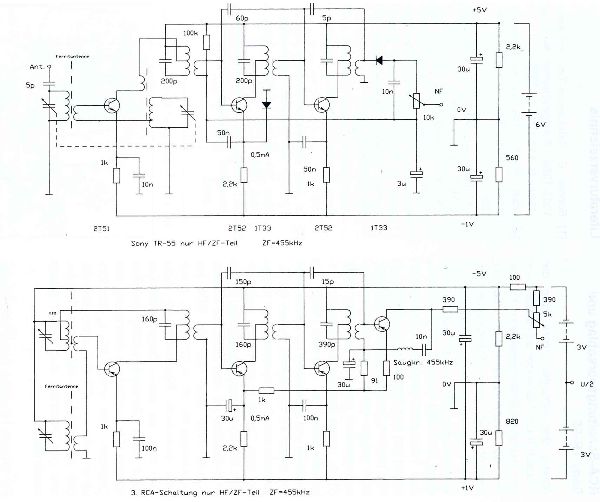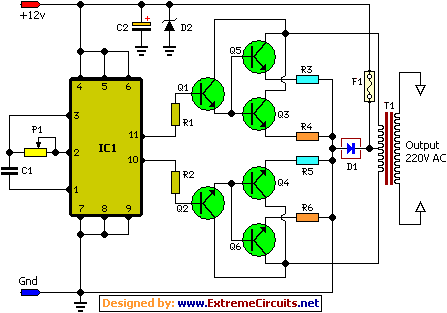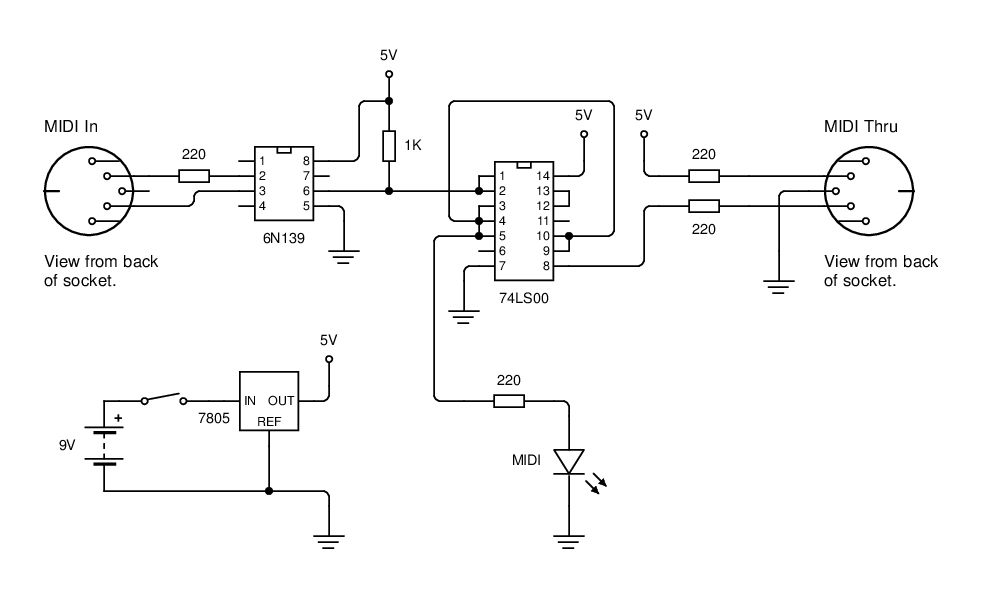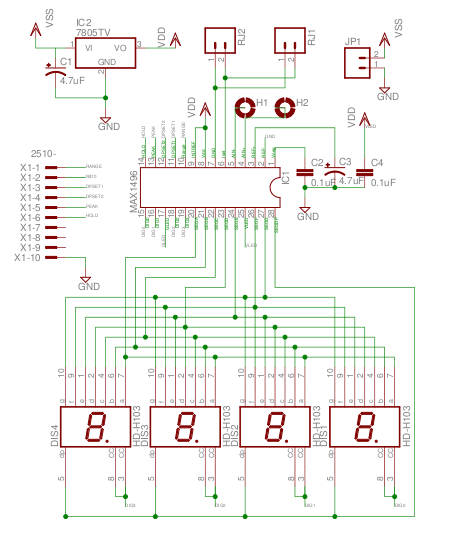
new pedal schematic

U1 (555 in monostable mode) generates a square wave signal that corresponds to the input signal. This square wave is then sent to the mixer (U2) along with the original signal for mixing, effectively functioning as a frequency doubler. Each note played will produce a square wave note of the same pitch alongside it. The two pitches, the original and the square wave, can be mixed together using two potentiometers to control the volume of each. The circuit produces a square wave note that accompanies the original note. However, it is important to note that the circuit may not operate as expected. The output frequency will be fixed and determined by the selected values of R1 and C1. For example, plucking the A string at 110 Hz will trigger the 555 timer 110 times per second, but the output frequency will remain constant based on R1 and C1. If these components are set too large, the output will still be cycling when a new input pulse arrives, resulting in staccato chirps. An alternative approach involves using an operational amplifier (op-amp) to process the input signal and then directing the op-amp output to two flip-flops—one triggered on the positive edge and the other on the negative edge. The outputs of the two flip-flops can be mixed using another op-amp, where one flip-flop generates the positive half of the waveform while the other generates the negative half, allowing for better tracking of the input frequency. Additionally, to generate a square wave at double the input frequency, the dual flip-flop circuit can be utilized. For the same frequency square wave, the input can be fed into an op-amp configured as a differentiator.
The circuit utilizes a 555 timer in monostable mode, which is configured to produce a square wave output. This output is dependent on the resistor (R1) and capacitor (C1) values, which set the timing characteristics of the 555 timer. When the input signal is detected, the timer is triggered, producing a square wave that matches the frequency of the incoming note. The mixer (U2) combines this square wave with the original audio signal, allowing musicians to blend the two sounds. The potentiometers provide user control over the relative volumes of the original signal and the square wave, enabling a tailored output sound.
However, the limitation of this design lies in its fixed output frequency, which may not accurately follow the dynamic nature of the input signal. The suggestion to employ an op-amp to process the input signal before it reaches the flip-flops offers a more versatile solution. By using two flip-flops, each responding to different edges of the input waveform, the circuit can produce a more accurate representation of the input frequency, resulting in a more coherent square wave output.
In summary, this circuit design presents an innovative approach to creating a square wave accompaniment for musical notes but requires careful consideration of component values and configurations to ensure optimal performance. The proposed modifications using op-amps and flip-flops enhance the circuit's ability to track input frequencies effectively, providing a more reliable and versatile sound generation tool for musicians.U1 (555 in monostable) creates a square wave signal to matchyour signal. then it sends that square wave into the mixer (u2) along with your original signal to be mixed. so it actually is a doubler. every note you play will have a square wave note of the same pitch right beside it! the two pitches, the original and the square wave are mixable this pedal makes a note of the same pitch, in square wave. it plays along with your notes. it has 2 potentiometers in there to control how loud each is. basically, you get a square wave note and your original note Interesting circuit, but I don`t think its going to work the way you think. The output frequency will be fixed, and will be determined by the value you select for r1 and c1. Lets say you pluck the A string. That will be 110hz. You`ll trigger the 555 110 times per second, but the output will always be a set frequency. If you set r1/c1 to be to large, the output will still be cycling when the new input pulse arrives. You`ll get some staccato chirps. Here`s another way to approach this. Bring the input into an opamp, then have the opamp output go to two flip-flops. One positive edge triggered, the other negative edge triggered. Mix the two outputs using another opamp. One FF generates the positive half of the waveform, and the other FF generates the negative half. That way, you`ll track the input frquency better. Edit: Btw, I wasn`t clear there. You`ld use the dual FF circuit to generate double the input frequency. For the same frequency squarewave, you`ld just run the input into an opamp configured as a differentiator.
🔗 External reference
The circuit utilizes a 555 timer in monostable mode, which is configured to produce a square wave output. This output is dependent on the resistor (R1) and capacitor (C1) values, which set the timing characteristics of the 555 timer. When the input signal is detected, the timer is triggered, producing a square wave that matches the frequency of the incoming note. The mixer (U2) combines this square wave with the original audio signal, allowing musicians to blend the two sounds. The potentiometers provide user control over the relative volumes of the original signal and the square wave, enabling a tailored output sound.
However, the limitation of this design lies in its fixed output frequency, which may not accurately follow the dynamic nature of the input signal. The suggestion to employ an op-amp to process the input signal before it reaches the flip-flops offers a more versatile solution. By using two flip-flops, each responding to different edges of the input waveform, the circuit can produce a more accurate representation of the input frequency, resulting in a more coherent square wave output.
In summary, this circuit design presents an innovative approach to creating a square wave accompaniment for musical notes but requires careful consideration of component values and configurations to ensure optimal performance. The proposed modifications using op-amps and flip-flops enhance the circuit's ability to track input frequencies effectively, providing a more reliable and versatile sound generation tool for musicians.U1 (555 in monostable) creates a square wave signal to matchyour signal. then it sends that square wave into the mixer (u2) along with your original signal to be mixed. so it actually is a doubler. every note you play will have a square wave note of the same pitch right beside it! the two pitches, the original and the square wave are mixable this pedal makes a note of the same pitch, in square wave. it plays along with your notes. it has 2 potentiometers in there to control how loud each is. basically, you get a square wave note and your original note Interesting circuit, but I don`t think its going to work the way you think. The output frequency will be fixed, and will be determined by the value you select for r1 and c1. Lets say you pluck the A string. That will be 110hz. You`ll trigger the 555 110 times per second, but the output will always be a set frequency. If you set r1/c1 to be to large, the output will still be cycling when the new input pulse arrives. You`ll get some staccato chirps. Here`s another way to approach this. Bring the input into an opamp, then have the opamp output go to two flip-flops. One positive edge triggered, the other negative edge triggered. Mix the two outputs using another opamp. One FF generates the positive half of the waveform, and the other FF generates the negative half. That way, you`ll track the input frquency better. Edit: Btw, I wasn`t clear there. You`ld use the dual FF circuit to generate double the input frequency. For the same frequency squarewave, you`ld just run the input into an opamp configured as a differentiator.
🔗 External reference





